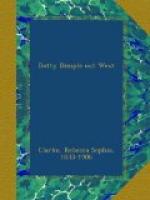[Illustration]
“The next day it rained so hard ‘the water couldn’t catch its breath’ but the Little Pitchers were eager to go to school.”
* * * * *
FLAXIE FRIZZLE.
“FLAXIE FRIZZLE is the successor of the Dotty Dimple, Little Prudy, Flyaway, and the other charming child creations of that inimitable writer for children, SOPHIE MAY. There never was a healthy, fun-loving child born into this world that, at one stage of another of its growth, wouldn’t be entertained with SOPHIE MAY’S books. For that matter, it is not safe for older folks to look into them, unless they intend to read them through. FLAXIE FRIZZLE will be found as bright and pleasant reading as the others.”—Boston Journal.
* * * * *
FLAXIE’S DOCTOR PAPA
“SOPHIE MAY understands children. Her books are not books about them merely. She seems to know precisely how they feel, and she sets them before us, living and breathing in her pages. Flaxie Frizzle is a darling, and her sisters, brothers, and cousins are just the sort of little folks with whom careful mothers would like their boys and girls to associate. The story is a bright, breezy, wholesome narrative, and it is full of mirth and gayety, while its moral teaching is excellent.”—Sunday School Times.
* * * * *
FLAXIE’S LITTLE PITCHERS
“Little Flaxie will secure a warm place in the hearts of all at once. Here is her little picture. Her name was Mary Gray, but they called her Flaxie Frizzle, because she had light curly hair that frizzled; and she had a curly nose,—that is, her nose curled up at the end a wee bit, just enough to make it look cunning. Her cheeks were rosy red, ’and she was so fat that when Mr. Snow, the postmaster, saw her, he said, “How d’ye do, Mother Bunch?"’”—Boston Home Journal.
* * * * *
SPECIMEN OF CUT TO “FLAXIE FRIZZLE SERIES.”
[Illustration]
“By and by the colts came to the kitchen window, which was open, and put in their noses to ask for something to eat. Flaxie gave them pieces of bread.”
* * * * *
FLAXIE’S TWIN COUSINS.
“Another of those sweet, natural child-stories in which the heroine does and says just such things as actual, live, flesh children do, is the one before us. And what is still better, each incident points a moral. The Illustrations are a great addition to the delight of the youthful reader. It is just such beautiful books as this which bring to our minds, in severe contrast, the youth’s literature of our early days—the good little boy who died young and the bad little boy who went fishing on Sunday and died in prison, etc., etc., to the end of the threadbare, improbable chapter.”—Rural New Yorker.




